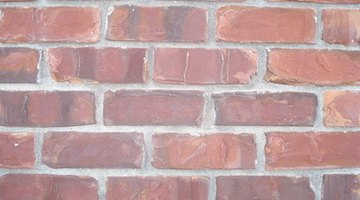How to Get Cat Urine Bacteria Out of Bricks
Cat urine has a pungent, unpleasant odor that can permeate your home. If your cat wets an area of brick inside or outside of your home, it can lead to the formation of bacteria. When bacteria grows within the porous brick, it forms an even stronger odor.

To remove this odor, you need to get rid of the urine in the brick and kill the bacteria that has formed. Clean your brick walkway, wall or flooring to remove the odor and chance of your cat re-marking the area.
Things You Will Need
- Water
- Enzymatic pet cleaner
- Towels
- Vinegar
- Spray bottle
- Brick/concrete sealant
-
Soak up any urine with towels. For older, dried stains, wet the area with water. Pour or spray an enzymatic pet cleaner on the brick to completely saturate it. Continue to wet the brick until you see the cleaner pool on the surface of the brick. You will use more cleaner on brick than on other surfaces since most brick is very porous and absorbs liquids unless sealed.
-
Soak a towel in enzymatic cleaner and place it over the stain to slow the drying process and allow the enzymes more time to eliminate the urine. For stains on walls where you cannot use the towel, re-saturate the area by spraying the cleaner one day after the initial application.
-
Let the brick dry to for two weeks to fully allow the enzymes in the cleaner to digest the urine particles completely. By digesting the urine particles, the cleaner also eliminates the bacteria and the odors. If necessary, you can treat the area again by soaking it in an enzymatic cleaner and allowing it to dry naturally for two additional weeks.
-
Pour or spray a mix of one part vinegar and one part water into the brick to neutralize the cat urine odor completely for stains that continue to remain and emit an odor. Vinegar kills the bacteria in the brick because it contains 5 percent acetic acid, according to Apple Cider Vinegar Benefits. Saturate the area until the vinegar and water mixture pools on top of the brick. Allow it to air dry completely.
-
Seal the brick with a silane/siloxane-based sealer for brick. This will protect the brick against any further damage from the urine, seal in any lingering odor and prevent water from reactivating the urine and causing bacterial growth if any urine remains. It will also make any future cat accidents on your brick easier to clean.
Tip
Substitute hydrogen peroxide for the vinegar and mix it with an equal part water to soak the brick. Pressure washing unsealed brick will push the urine further into the brick and encourage bacterial growth. Clean urine stains on porous brick immediately to prevent it from setting and causing bacteria to grow in the brick.
Warning
Do not use any cleaners on the brick before you apply the enzymatic cleaner. Other cleaners can weaken the enzymes, reducing its effectiveness. If you did use another cleaner, wait two weeks before using an enzyme-based cleaner on the brick.
Do not use ammonia to clean cat urine from bricks. Ammonia enhances the odor of the urine and encourages cats to continue urine-marking the area.
The Drip Cap
- Cat urine has a pungent, unpleasant odor that can permeate your home.
- To remove this odor, you need to get rid of the urine in the brick and kill the bacteria that has formed.
- Soak up any urine with towels.
- Pour or spray a mix of one part vinegar and one part water into the brick to neutralize the cat urine odor completely for stains that continue to remain and emit an odor.
- Allow it to air dry completely.
References
Writer Bio
Susan Paretts loves to tackle home improvement projects and has contributed to a variety of publications regarding home repair and home decor, including eHow, SFGate, Hunker, Apartment Therapy and House Beautiful among others. Her expertise is in home repair, home decor, home staging and DIY.
Photo Credits
- Brick image by Luke Haverkamp from Fotolia.com
- Brick image by Luke Haverkamp from Fotolia.com
More Articles



